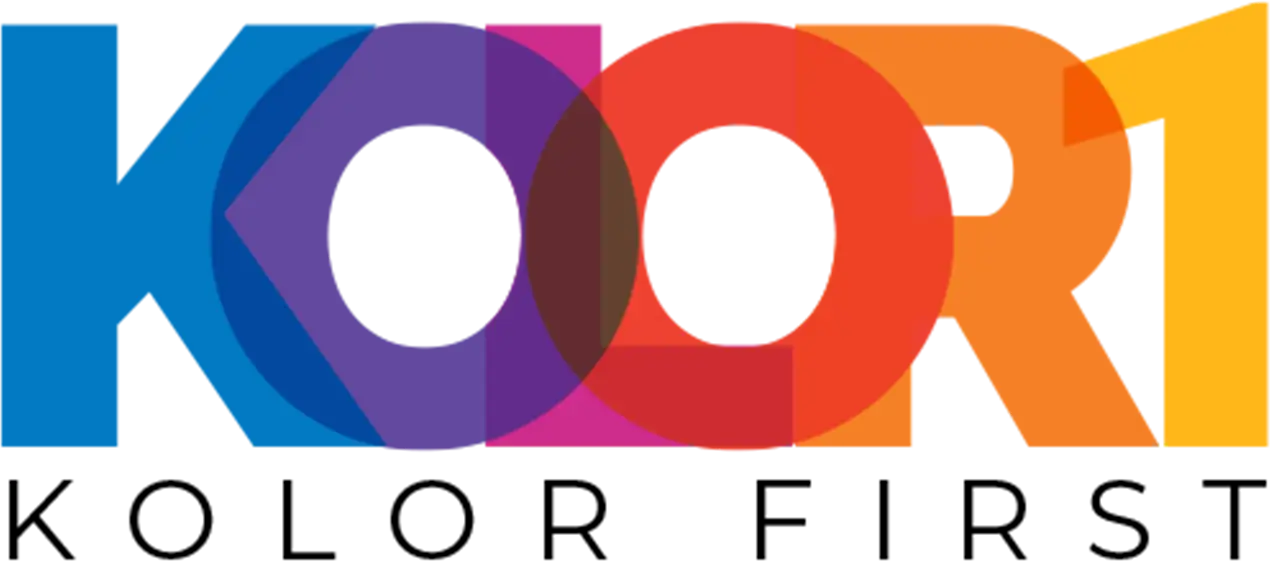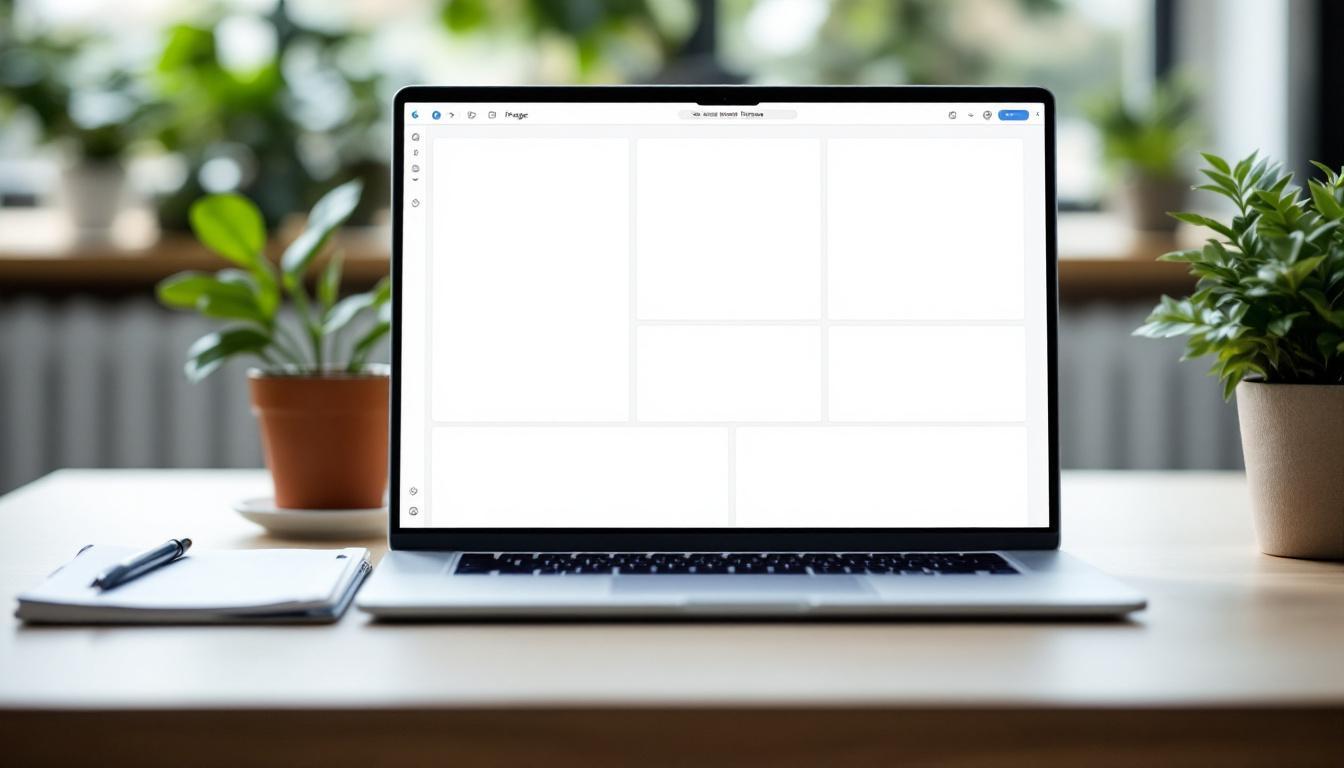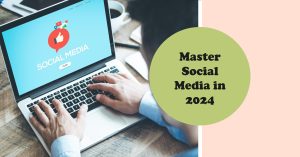Marketing web page design can make or break your online success. At Kolorfirst LLC, we’ve seen firsthand how well-crafted pages drive conversions and boost business growth.
This post will guide you through the essential elements, design principles, and best practices for creating effective marketing web pages. By implementing these strategies, you’ll be able to captivate your audience and achieve your marketing goals.
What Makes a Marketing Web Page Effective?
At Kolorfirst LLC, we’ve identified key elements that transform ordinary web pages into powerful marketing tools. These components work together to create a compelling user experience that drives conversions and boosts your bottom line.
Craft a Clear Value Proposition
Your value proposition is the cornerstone of your marketing web page. It should immediately answer the question, “Why should I choose your product or service?” Place it prominently above the fold, using concise language that highlights your unique benefits. A clear value proposition has the potential to dramatically improve your conversion rate. Many marketers shy away from crafting an effective value proposition, but it’s crucial for success.
Design Irresistible Call-to-Action Buttons
Call-to-action (CTA) buttons are your conversion drivers. Make them stand out with contrasting colors and action-oriented text. Try CTAs like “Start Your Free Trial” or “Get Your Custom Quote” that create a sense of ownership for the user.
Leverage High-Quality Visuals
Visual content is processed much faster than text. Use high-quality, relevant images and videos that showcase your product or service in action. Avoid generic stock photos; instead, opt for custom photography or illustrations that align with your brand identity.
Incorporate Social Proof
Nothing builds trust like social proof. Include customer testimonials, case studies, and trust badges prominently on your page. Feature real customer quotes with names and photos for maximum impact. If you’ve worked with well-known brands, showcase their logos to leverage their credibility.
Prioritize Mobile-Friendly Design
Mobile devices are driving about 59.7% of global website traffic as of April 2025, making a mobile-friendly design non-negotiable. Implement responsive design techniques to ensure your page looks great on all screen sizes. Google’s mobile-first indexing means that mobile-optimized sites are more likely to rank higher in search results.
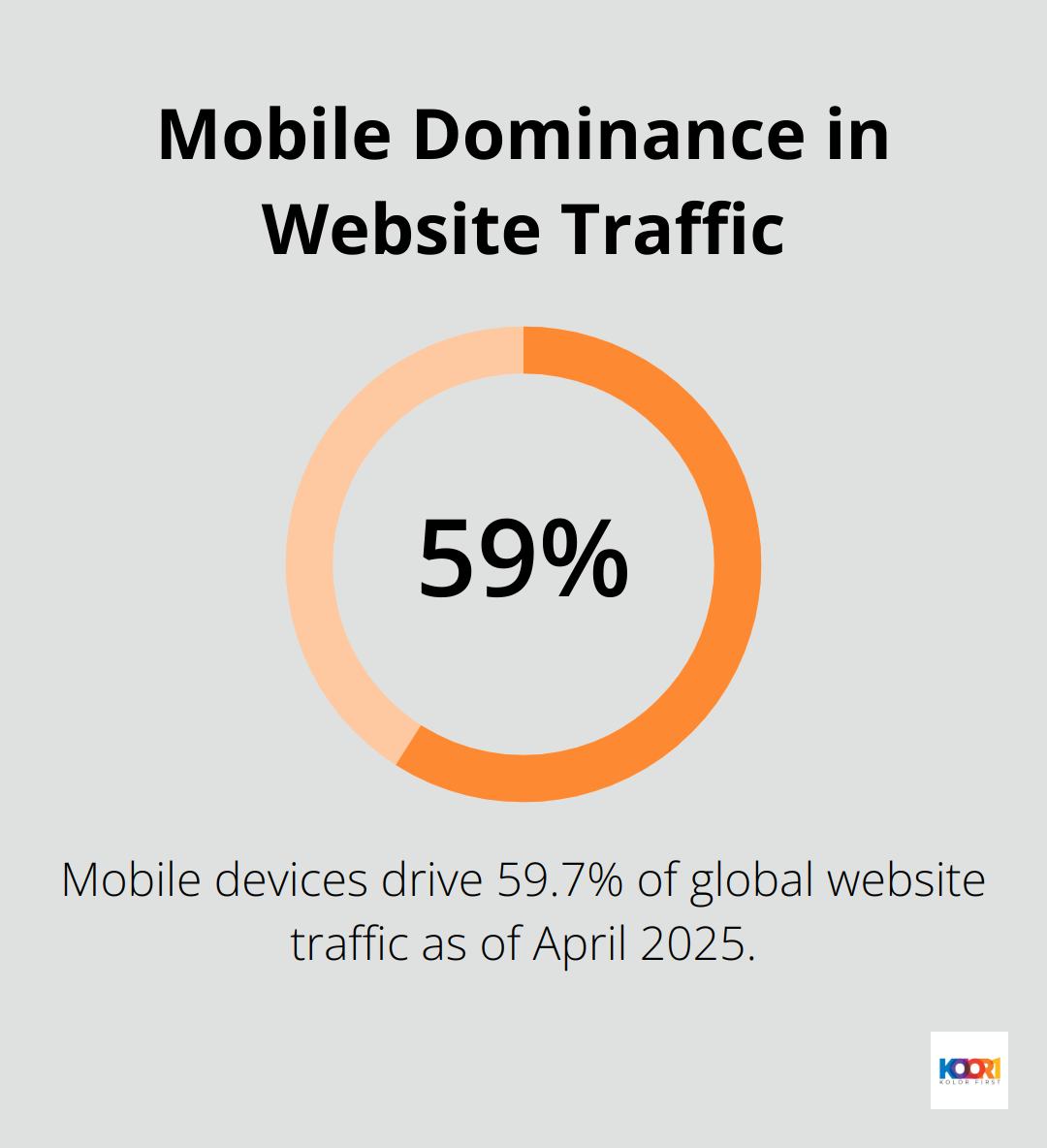
These key elements will help you create marketing web pages that not only look great but also deliver results. The next section will explore the design principles that complement these elements and enhance your page’s effectiveness.
How Design Principles Enhance Your Marketing Web Pages
At Kolorfirst LLC, we apply key design principles to transform marketing web pages from mediocre to magnificent. These essential design elements will make your pages stand out and convert.
The Power of White Space
White space (or negative space) is a secret weapon for creating clean, focused layouts. Strategic use of empty areas guides users’ attention to important elements. White space highlights the most important parts of a page, clearing the visual hierarchy for visitors and increasing their confidence.
Consistent Brand Experience
Your web page should extend your brand identity. Use your brand’s color palette consistently throughout the page. Limit yourself to 2-3 primary colors and 2-3 accent colors for optimal visual harmony. Stick to your brand’s typography, using no more than two font families. This consistency builds trust and recognition, which can lead to a 33% increase in brand recognition (as reported by Lucidpress).

Visual Hierarchy
Organize your content to naturally lead the eye through the most important information. Use size, color, and positioning to emphasize key elements. Users typically scan web pages in an F-shaped pattern. Place your most important content along this path to maximize engagement. Implement a clear heading structure (H1, H2, H3) to break up content and improve readability.
Simplified Navigation
Intuitive navigation keeps users engaged. Limit your main navigation menu to 5-7 items. Use descriptive labels that clearly indicate what users will find. For complex site structures, consider a mega menu or dropdown navigation. Simplified Navigation keeps users engaged and improves the overall user experience.
Speed Optimization
Page load speed is critical for user experience and SEO. Try to achieve a load time of under 3 seconds. As page load time increases from 1 to 3 seconds, the probability of bounce increases by 32% (according to Google). To achieve this, compress images, minify CSS and JavaScript, and leverage browser caching. A content delivery network (CDN) can serve assets from servers closer to your users’ geographic locations.
These design principles create marketing web pages that look professional and drive results. Great design creates an intuitive, engaging experience that guides users towards conversion. Now, let’s explore how to optimize your conversion rates through data-driven strategies and user-centric approaches.
How to Boost Your Conversion Rates
At Kolorfirst LLC, we’ve observed how minor adjustments can lead to significant improvements in conversion rates. Let’s explore some proven strategies that can help you transform more visitors into customers.
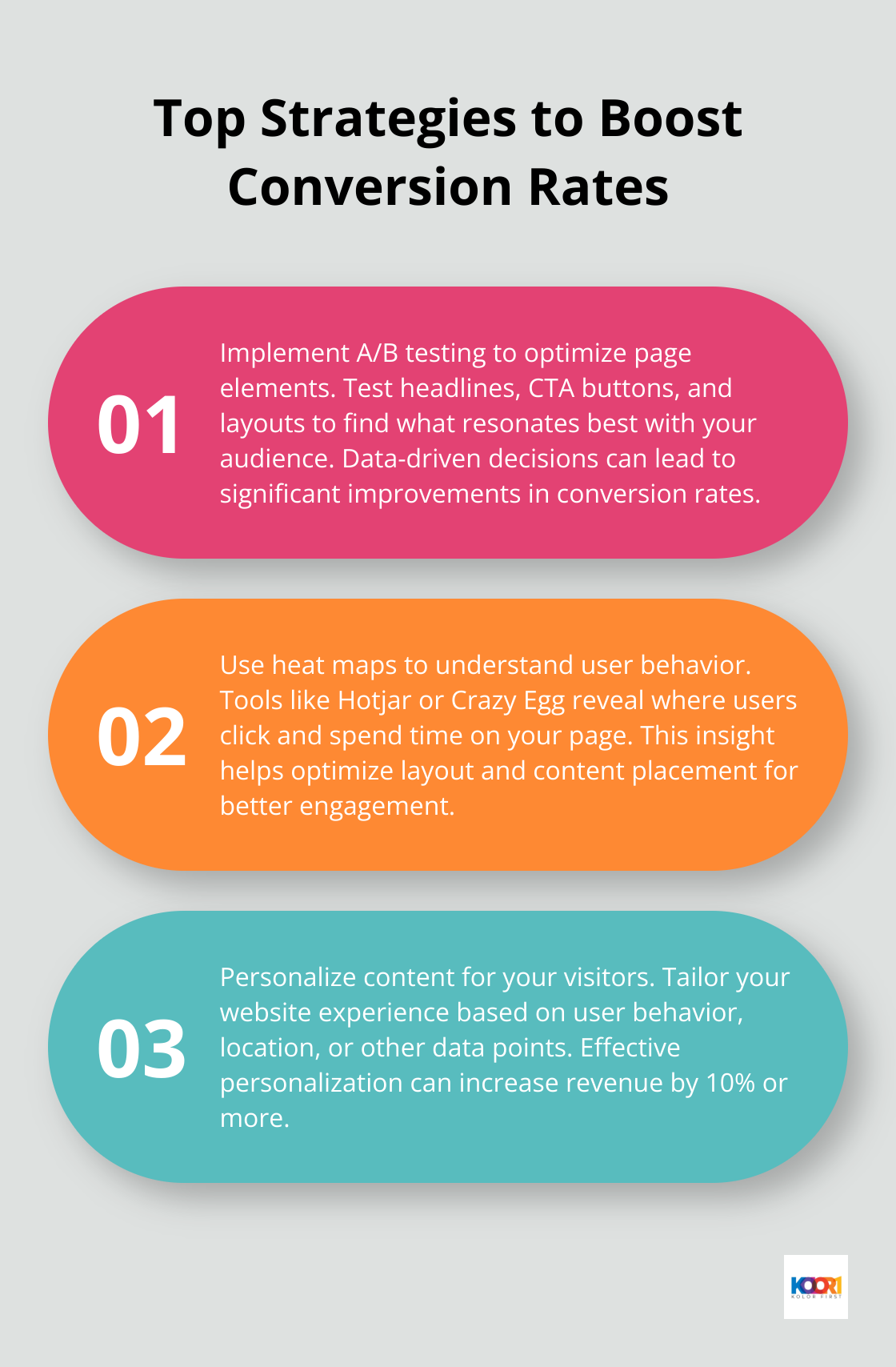
A/B Testing for Optimization
A/B testing is a powerful tool for optimizing conversions. Test one element at a time – your headline, CTA button color, or form layout. Tools like Optimizely or Google Optimize simplify these experiments. It’s important to ensure that testing variations in page content or URLs has minimal impact on your Google Search performance.
For instance, a SaaS client tested two different headlines. The version focusing on the problem their software solved outperformed the feature-focused headline by 32%. Don’t assume you know what works best – let data guide your decisions.
Heat Maps Reveal User Behavior
Heat maps provide valuable insights into user behavior. Tools like Hotjar or Crazy Egg offer visual representations of where users click, scroll, and spend time on your page. This data proves invaluable for optimizing your layout and content placement.
An e-commerce client discovered users rarely scrolled past the fold on product pages. Moving key product details and the “Add to Cart” button higher on the page resulted in a 15% increase in conversions.
Content Personalization
Personalization can significantly boost engagement and conversions. Use tools like Dynamic Yield or Optimizely to serve different content based on user behavior, location, or other data points. Recent studies show that 47% to 76% of consumers anticipate personalized interactions with brands, and when done effectively, personalization can increase revenue by 10% or more.
Start small – personalize your homepage headline based on whether a visitor is new or returning. Then, expand to more sophisticated personalization strategies as you gather more data.
Streamlined Forms and Checkout
Every field you add to a form increases abandonment likelihood. Analyze your forms and remove unnecessary fields. For e-commerce sites, implement a guest checkout option – research shows that 24% of users abandon carts when forced to create an account.
Consider multi-step forms for longer processes. Breaking the form into smaller, more manageable steps can reduce overwhelm and increase completion rates. A client saw a 28% increase in form submissions after switching to a multi-step design.
Urgency Creation
Urgency and scarcity are powerful motivators. Use countdown timers for limited-time offers, show low stock warnings, or highlight exclusive deals. But be cautious – false urgency can backfire and erode trust. Always be honest and use these tactics sparingly.
A travel booking site saw a 9% increase in bookings by adding a simple “Only 2 rooms left at this price!” message to their hotel listings. It’s a small change that can make a big difference.
Final Thoughts
Marketing web page design combines creativity and data-driven strategies. We explored key elements, design principles, and conversion optimization techniques. These strategies transform ordinary pages into powerful marketing tools that captivate audiences and drive business growth.
Effective design requires continuous improvement and adaptation. We recommend you start small, focus on one or two areas, and measure the results. You can redesign your CTA buttons or streamline your checkout process to see immediate impact on your conversion rates and user engagement metrics.
At Kolorfirst LLC, we specialize in creating marketing web pages that deliver results. Our team crafts unique brand identities and enhances online presence through engaging user experiences. We invite you to apply these principles to your marketing efforts and watch your business thrive.

